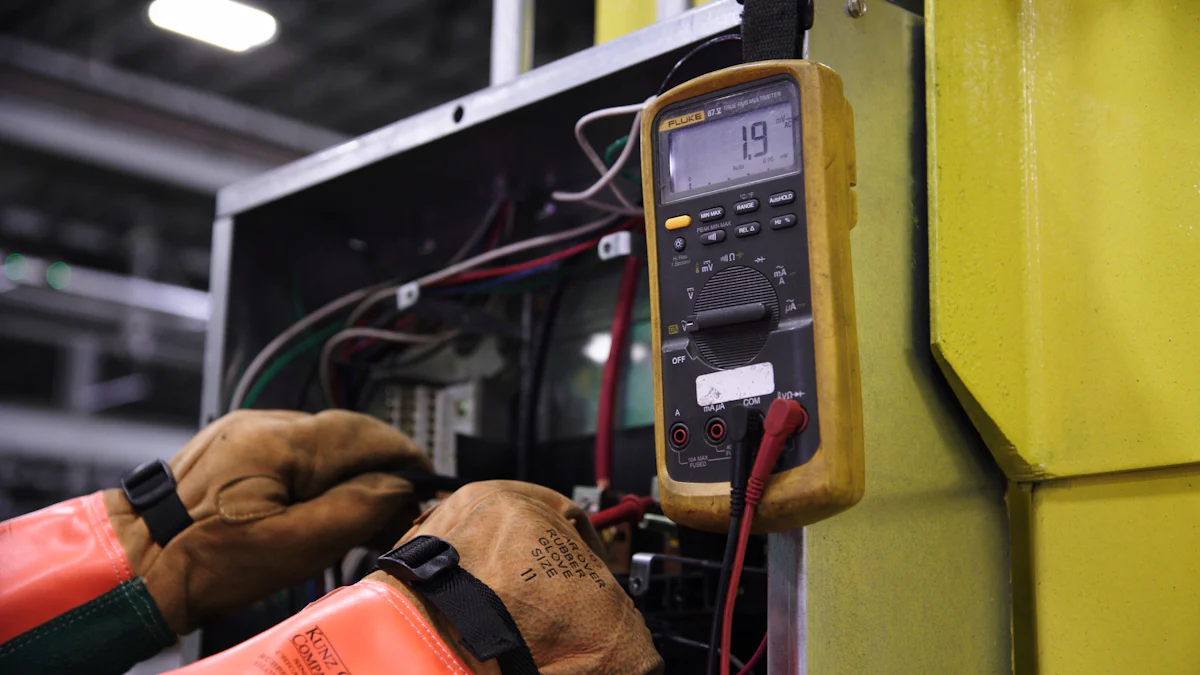
News
The low voltage variable frequency drive (VFD) market shows promising growth patterns. In 2022, the market reached approximately USD 18.5 billion. Analysts project a compound annual growth rate (CAGR) of around 7.2% from 2023 to 2030. This growth trajectory stems from increasing industrial automation and the rising demand for energy-efficient solutions. Industries such as HVAC, water and wastewater treatment, and manufacturing contribute significantly to this expansion. Understanding the market status of low voltage VFDs provides valuable insights into its current position and future potential.
Key Takeaways
The low voltage VFD market is projected to grow at a CAGR of 7.2%, reaching approximately USD 30.61 billion by 2032, driven by industrial automation and energy efficiency demands.
Technological advancements, including IoT integration and AI, are enhancing the performance and appeal of VFDs, making them essential for modern industrial applications.
Industries such as HVAC, water treatment, and manufacturing are key contributors to the rising demand for VFDs, highlighting their importance in achieving energy efficiency and cost savings.
Despite growth potential, challenges like high installation costs and integration complexities must be addressed to ensure broader adoption of VFD technology.
Regions like Asia-Pacific are emerging as significant markets due to rapid industrialization and infrastructure development, presenting opportunities for investment and innovation.
Major players like ABB and Siemens lead the market with innovative solutions, while emerging companies are carving out niches by focusing on energy-efficient technologies.
Stakeholders should leverage advancements in VFD technology to optimize operations and enhance energy efficiency, ensuring competitiveness in a rapidly evolving market.
Market Status of Low Voltage VFDs
Current Market Size
The market status of low voltage VFDs reflects a robust and expanding sector. In 2023, the market size reached approximately USD 18.99 billion. This figure underscores the significant demand for low voltage VFDs across various industries. The increasing need for energy-efficient solutions and industrial automation drives this growth. As industries like HVAC, water treatment, and manufacturing continue to adopt these technologies, the market size is expected to grow further.
Historical Growth Patterns
Historically, the market status of low voltage VFDs has shown consistent growth. Over the past decade, the market has expanded due to technological advancements and increased industrial applications. The demand for energy-efficient systems has played a crucial role in this growth. The market's historical trajectory indicates a steady rise, with a notable increase in adoption rates across different regions. This pattern highlights the growing recognition of VFDs as essential components in modern industrial operations.
Projected Market Growth
Looking ahead, the market status of low voltage VFDs is poised for continued expansion. Analysts project a growth rate from 2023 to 2032 at a compound annual growth rate (CAGR) of 5%. By 2032, the market size is expected to reach USD 30.61 billion. This growth is driven by several factors, including rising electricity demand and the push for sustainable energy solutions. The Asia Pacific region, in particular, is anticipated to experience significant growth due to increased industrialization and infrastructure development. As industries worldwide prioritize energy efficiency, the market for low voltage VFDs will likely see substantial advancements.
Key Drivers and Challenges in the Variable Frequency Drive Market
Technological Advancements
Technological advancements play a pivotal role in shaping the variable frequency drive market. Innovations in digitalization and the integration of the Internet of Things (IoT) have revolutionized the development of smart VFDs. These advancements enhance energy efficiency and improve control schemes, making VFDs more appealing to various industries. Recent improvements in safety features and the incorporation of machine learning and artificial intelligence (AI) further boost the market's growth. AI and machine learning enable VFDs to predict load fluctuations, identify system anomalies, and automatically fine-tune settings, optimizing performance and efficiency. As technology continues to evolve, the market for low voltage frequency drives is expected to expand, driven by these cutting-edge innovations.
Increasing Demand in Industrial Applications
The industrial and manufacturing sectors significantly contribute to the rising demand for variable frequency drives. VFDs optimize motor speed and torque, enhancing performance and efficiency in various applications. Industries such as HVAC, water and wastewater treatment, and manufacturing rely heavily on VFDs to achieve energy efficiency and cost savings. The ability of VFDs to provide adjustable speed drives makes them indispensable in these sectors. As industries strive for sustainable energy solutions, the demand for VFDs continues to grow, supporting long-term market growth. The increasing need for energy-efficient systems in industrial applications underscores the importance of VFDs in modern operations.
Challenges in Market Penetration
Despite the promising market growth, the variable frequency drive market faces several challenges in market penetration. The cost associated with installing VFD devices can hinder widespread adoption, particularly in smaller enterprises. Additionally, the complexity of integrating VFDs into existing systems poses a challenge for some industries. Market players must address these barriers to ensure broader adoption and sustained growth. Overcoming these challenges requires strategic investments in research and development to create cost-effective solutions and simplify integration processes. By addressing these issues, the market can achieve its full potential and continue to expand across various sectors.
Regional Influences on the Global Variable Frequency Drive Market

North America
North America plays a significant role in the global variable frequency drive market. The region benefits from advanced technological infrastructure and a strong emphasis on energy efficiency. Industries in North America, such as manufacturing and automotive, increasingly adopt variable frequency drives to enhance operational efficiency. The regulatory environment also supports the adoption of energy-efficient technologies, further driving market growth. As a result, North America remains a key player in the global market size, contributing significantly to the overall expansion of the sector.
Europe
Europe's influence on the global variable frequency drive market is notable due to its commitment to sustainable practices and stringent energy regulations. European countries prioritize reducing carbon emissions and improving energy efficiency, which boosts the demand for variable frequency drives. The industrial sector in Europe, including automotive and renewable energy, relies heavily on these drives to optimize processes and reduce energy consumption. This focus on sustainability and innovation positions Europe as a crucial region in the global market, driving advancements and setting standards for energy-efficient technologies.
Asia-Pacific
Asia-Pacific emerges as a rapidly growing region in the global variable frequency drive market. The region's industrialization and infrastructure development fuel the demand for energy-efficient solutions. Countries like China and India experience significant growth due to increasing investments in manufacturing and construction sectors. The rising emphasis on sustainable practices and regulatory support for energy efficiency further bolster market growth in Asia-Pacific. This region presents lucrative opportunities for investment and innovation, making it a focal point for companies aiming to expand their presence in the global market.
Rest of the World
The low voltage variable frequency drive (VFD) market extends beyond the major regions of North America, Europe, and Asia-Pacific. Other parts of the world, including Latin America, the Middle East, and Africa, also contribute to the global market landscape. These regions present unique opportunities and challenges that shape the market dynamics.
1. Latin America
Latin America shows promising growth potential in the VFD market. The region's increasing focus on sustainable practices and energy efficiency drives demand for VFDs. Countries like Brazil and Mexico invest in industrial automation and infrastructure development, creating a fertile ground for market expansion. The adoption of VFDs in sectors such as manufacturing and energy production supports this growth trajectory.
2. Middle East and Africa
The Middle East and Africa region also play a significant role in the global VFD market. The demand for energy-efficient solutions rises as countries in this region aim to diversify their economies and reduce reliance on oil. Investments in renewable energy projects and industrial sectors boost the adoption of VFDs. The region's regulatory support for energy efficiency further enhances market growth prospects.
3. Challenges and Opportunities
Despite the growth potential, the VFD market in these regions faces challenges. Economic instability and limited technological infrastructure can hinder market penetration. However, these challenges also present opportunities for companies to innovate and offer tailored solutions. By addressing these barriers, businesses can tap into the untapped potential of these emerging markets.
Major Players in the Low Voltage Drives Market

Leading Companies
The low voltage drives market features several leading companies that have established a strong presence. These companies dominate the market share due to their extensive product portfolios and innovative solutions. ABB, Siemens, and Schneider Electric are among the top players. They offer a wide range of products catering to various industrial needs, including the HVAC application segment. Their focus on energy efficiency and energy saving has positioned them as leaders in the variable frequency drive market. These companies continuously invest in research and development to enhance their offerings and maintain their competitive edge.
Emerging Players
Emerging players in the low voltage drives market are gaining traction by introducing innovative technologies and targeting niche markets. Companies like Yaskawa Electric Corporation and Fuji Electric are making significant strides. They focus on developing low-voltage AC drive market solutions that cater to specific industrial applications. These emerging players emphasize energy efficiency of buildings and energy saving, which aligns with the growing demand for sustainable solutions. Their ability to adapt to changing market dynamics and offer customized products contributes to their increasing market share.
Competitive Landscape
The competitive landscape of the low voltage drives market is characterized by intense rivalry among established and emerging players. Technological advancements and broader adoption across emerging markets drive steady growth in the variable frequency drive market. Manufacturers are developing products to cater to diverse industrial needs, fostering innovation and competitiveness. The expanding industrial automation sector and the trend of industrial digitization present significant opportunities for market expansion. Companies strive to differentiate themselves by offering superior products and services, enhancing their market position.
The low voltage VFD market demonstrates a robust growth trajectory, driven by technological advancements and increasing demand across various industries. Key players like ABB Ltd, Siemens AG, and Danfoss A/S lead the market with innovative solutions that enhance energy efficiency and system performance. Emerging companies such as Fuji Electric Co. Ltd and Mitsubishi Electric Corporation contribute to the competitive landscape by offering specialized products. Stakeholders should focus on leveraging these advancements to optimize operations and reduce energy consumption, ensuring sustainable growth and competitiveness in the evolving market.
FAQ
What is a Variable Frequency Drive (VFD)?
A Variable Frequency Drive (VFD) is a type of motor controller that drives an electric motor by varying the frequency and voltage of its power supply. It also has the capability to control ramp-up and ramp-down of the motor during start or stop, respectively. VFDs are used in applications ranging from small appliances to large compressors.
What factors contribute to the growth of the variable frequency drive market?
Several factors contribute to the growth of the variable frequency drive market. These include increasing demand for energy-efficient solutions, technological advancements, and the globalization of industrial operations. The market also benefits from a favorable economic environment that encourages investment in innovative products.
What is the forecast for the variable frequency drive market?
The forecast for the variable frequency drive market indicates steady growth over the coming years. Analysts project a compound annual growth rate (CAGR) driven by rising demand for energy-efficient solutions and technological advancements. The market is expected to expand significantly, with increased adoption across various industrial sectors.
Please give us a message